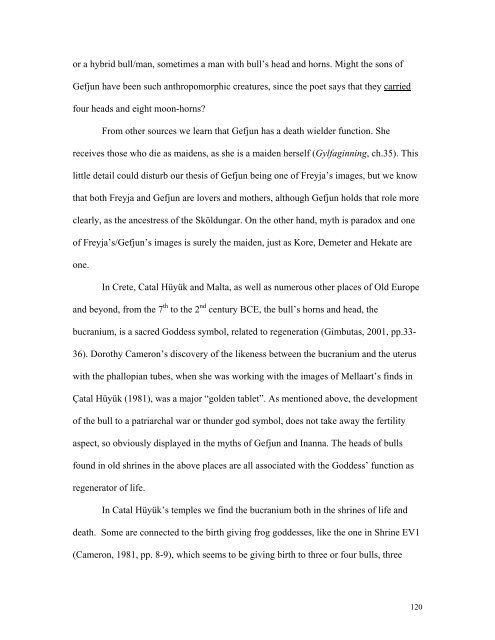Create successful ePaper yourself
Turn your PDF publications into a flip-book with our unique Google optimized e-Paper software.
or a hybrid bull/man, sometimes a man with bull’s head <strong>and</strong> horns. Might the sons <strong>of</strong><br />
Gefjun have been such anthropomorphic creatures, since the poet says that they carried<br />
four heads <strong>and</strong> eight moon-horns?<br />
From other sources we learn that Gefjun has a death wielder function. She<br />
receives those who die as maidens, as she is a maiden herself (Gylfaginning, ch.35). This<br />
little detail could disturb our thesis <strong>of</strong> Gefjun being one <strong>of</strong> Freyja’s images, but we know<br />
that both Freyja <strong>and</strong> Gefjun are lovers <strong>and</strong> mothers, although Gefjun holds that role more<br />
clearly, as the ancestress <strong>of</strong> the Sköldungar. On the other h<strong>and</strong>, myth is paradox <strong>and</strong> one<br />
<strong>of</strong> Freyja’s/Gefjun’s images is surely the maiden, just as Kore, Demeter <strong>and</strong> Hekate are<br />
one.<br />
In Crete, Catal Hüyük <strong>and</strong> Malta, as well as numerous other places <strong>of</strong> Old Europe<br />
<strong>and</strong> beyond, from the 7 th to the 2 nd century BCE, the bull’s horns <strong>and</strong> head, the<br />
bucranium, is a sacred Goddess symbol, related to regeneration (Gimbutas, 2001, pp.33-<br />
36). Dorothy Cameron’s discovery <strong>of</strong> the likeness between the bucranium <strong>and</strong> the uterus<br />
with the phallopian tubes, when she was working with the images <strong>of</strong> Mellaart’s finds in<br />
Çatal Hüyük (1981), was a major “golden tablet”. As mentioned above, the development<br />
<strong>of</strong> the bull to a patriarchal war or thunder god symbol, does not take away the fertility<br />
aspect, so obviously displayed in the myths <strong>of</strong> Gefjun <strong>and</strong> Inanna. <strong>The</strong> heads <strong>of</strong> bulls<br />
found in old shrines in the above places are all associated with the Goddess’ function as<br />
regenerator <strong>of</strong> life.<br />
In Catal Hüyük’s temples we find the bucranium both in the shrines <strong>of</strong> life <strong>and</strong><br />
death. Some are connected to the birth giving frog goddesses, like the one in Shrine EV1<br />
(Cameron, 1981, pp. 8-9), which seems to be giving birth to three or four bulls, three<br />
120


